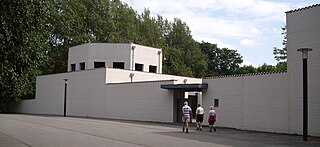Related Research Articles

Zegge is a village located in the municipality of Rucphen, North Brabant in the Netherlands. On 1 January 2020, the village had 2,045 inhabitants. Viewed from the four other villages in the municipality of Rucphen, Zegge is located on the other side of the A58 motorway. This combined with its small size, makes it so that much of the daily life of its inhabitants centers around the nearby city of Roosendaal.

Pieter Hemony and his brother François Hemony were the greatest bellfounders in the history of the Low Countries. They developed the carillon, in collaboration with Jacob van Eyck, into a full-fledged musical instrument by casting the first tuned carillon in 1644.

Brecht Abbey, also known as the Abbey of Our Lady of Nazareth, is an abbey of Trappistine nuns located in Brecht, in the Campine region of the province of Antwerp. Life in the abbey is characterized by prayer, reading and manual work, the three basic elements of Trappist life.

Keizersberg Abbey, also known as Mont César Abbey is a Benedictine monastery on the hill Keizersberg or Mont César in the north of the university town of Leuven, Belgium.
Jean d'Oisy (1310–1377) was the architect of several ecclesiastical buildings in Brabantine Gothic style. He was one of the earliest introducers of northern French Gothic style into the Low Countries and a teacher of the reputed Brabantian architect Jacob van Thienen.

The Church of Our Lady of Victories at the Sablon, or the Church of Our Lady of the Sablon, is a Catholic church located in the Sablon/Zavel district, in the historic centre of Brussels, Belgium. It is dedicated to Our Lady of the Sablon.

Nieuwenbosch Abbey, also Nieuwenbos Abbey was a Cistercian nunnery in Heusden, East Flanders, Belgium, later relocated to Ghent.

Ter Doest Abbey was a Cistercian abbey in Belgium, in the present Lissewege, a district of Bruges, West Flanders.

Male Castle, Bruges. A community of the Canonesses Regular of the Holy Sepulchre. It originated in Bruges in the 11th century, and between 1954 and 2013 was settled in Male Castle in Male, Sint-Kruis, Bruges, West Flanders, Belgium.

Roosenberg Abbey was established in 1238 at Waasmunster, halfway between Ghent and Antwerp. The abbey is still operating at Waasmunster, though not on its original site. Its 750-year history has not been uninterrupted.

Koningshoeven Abbey is a monastery of the Trappists founded in 1881 in Berkel-Enschot in North Brabant, the Netherlands.
CornilCacheux was a French pipe organ maker.

Ten Duinen Abbey or the Abbey of the Dunes was a Cistercian monastery at Koksijde in what is now Belgium. It was one of the richest and most influential religious institutions in the medieval County of Flanders. It later relocated from Koksijde to the city of Bruges.

Oosteeklo is a historic village in the Flemish province of East Flanders, Belgium, which since 1977 has been a subdivision of the municipality of Assenede. The village is situated 9 km east of Eeklo and 17 km north of Ghent, about 9 km from the border with the Netherlands, and lies approximately 9 metres above sea-level.

Ninove Abbey was a monastery of the Premonstratensian Order in the center of Ninove, in the province of East Flanders, Belgium. Only the abbey church now remains.

Jacobus van Eynde or van den Eynde was a Flemish organ builder.
References
- ↑ Inventaris: Lyceum O-L-V ter Nieuwe Plant
- ↑ DBNL.org: Onze-Lieve-Vrouwe ter Nieuwe Plant foundation story
- 1 2 3 Dom Anselm Hoste, 1986
- ↑ Titus Brandsma Instituut: Moderne Devotie (Collatie 26) Archived 2016-03-03 at the Wayback Machine (in Dutch)]